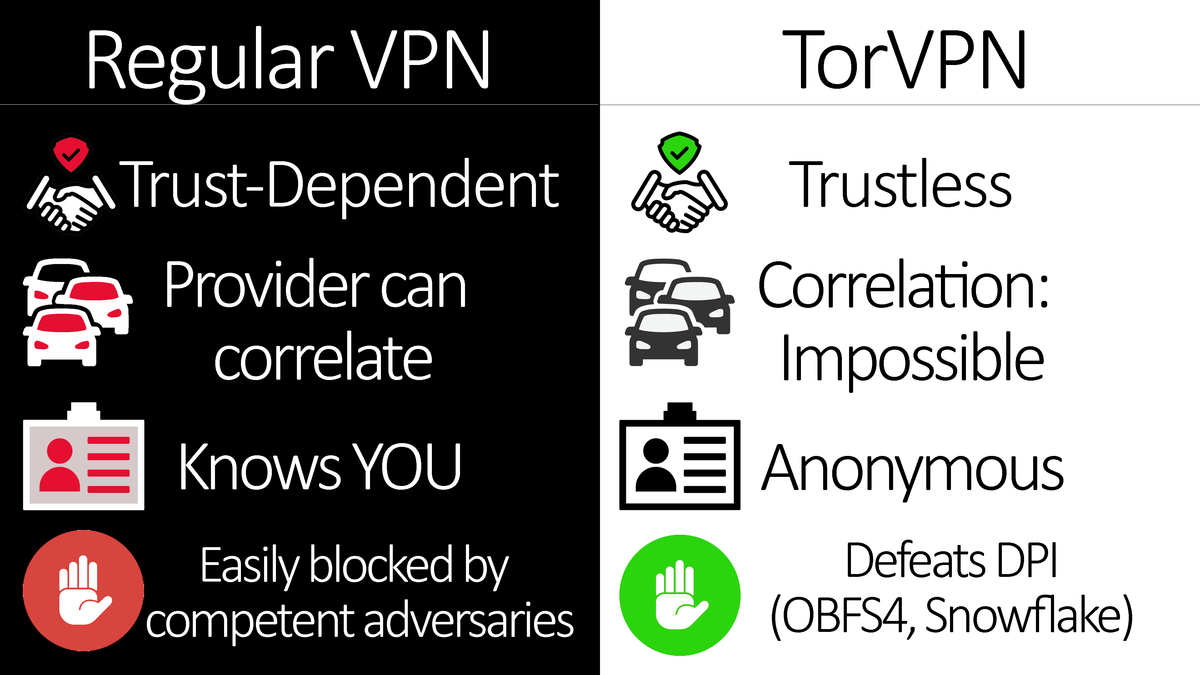Why TorVPN's OnionMasq Architecture Destroys Traditional VPN Security
The Tor Project's new Android VPN application fundamentally restructures mobile anonymity through per-app circuit isolation, making commercial VPN trust assumptions obsolete while providing automatic censorship circumvention that adapts faster than authoritarian blocking attempts.

Commercial VPN providers have built their entire business model on a fundamental lie. They promise anonymity while funneling all user traffic through single company servers where complete surveillance becomes trivial. Every packet, every DNS query, every application connection flows through infrastructure controlled by corporations that maintain detailed logs despite marketing claims to the contrary. When law enforcement arrives with paperwork, these same companies that advertise privacy protection hand over user data without resistance.
The Tor Project's new TorVPN application for Android demolishes this surveillance architecture through OnionMasq integration. Unlike traditional VPN services that create one encrypted tunnel to corporate servers, TorVPN embeds a complete Tor client directly into Android's VPN framework. User traffic bounces through three random relay operators across different countries before exiting, with each relay knowing only the previous and next hop in the chain. This distributed trust model eliminates the single point of failure that makes commercial VPNs fundamentally compromised.
OnionMasq provides granular control that exposes how primitive traditional VPN architectures really are. The implementation tracks individual application metrics through functions like getBytesReceivedForApp and refreshCircuitsForApp, enabling per-application routing through different country combinations. Instagram traffic might route through Germany, Poland, and Brazil while Signal simultaneously travels through France, Canada, and Japan. Commercial VPN providers see one encrypted blob heading to their servers and physically cannot distinguish between different applications.
Per-app circuit isolation represents the most significant advancement in mobile anonymity since smartphones existed. Each protected application maintains completely separate Tor circuits with independently rotating circuit pools. This architectural approach makes cross-application traffic correlation mathematically impossible rather than simply difficult. Banking applications never share relay paths with social media traffic, creating isolation barriers that no commercial VPN can provide. Traditional services push everything through shared connection points where correlation remains feasible.
Pluggable transport technology gives TorVPN censorship resistance capabilities that commercial VPNs cannot match. Standard VPN protocols like OpenVPN and WireGuard use fixed, recognizable signatures that censors can detect and block efficiently. When China updates their blocking infrastructure, commercial VPN subscriptions become worthless overnight because they only know one connection method. TorVPN switches between multiple transport mechanisms automatically. The obfs4 protocol scrambles Tor traffic to look like random garbage data without discernible patterns, defeating deep packet inspection systems. Snowflake uses WebRTC technology to tunnel connections through volunteer proxies, making traffic appear identical to video calls.
The circumvention API represents another revolutionary advancement over static VPN server lists. Instead of manually copying bridge lines from emails like some antiquated process from 1995, TorVPN dynamically fetches working bridges based on current network conditions. This automatic adaptation protects users who lack technical expertise to understand bridge configuration while ensuring connectivity remains possible even under aggressive blocking attempts. Commercial VPN services ship with static server lists that competent censors can block before lunch.
DNS resolution through virtual endpoints eliminates another surveillance vector that commercial VPNs ignore. Traditional VPN providers redirect DNS queries to their own servers where they log every domain users request. TorVPN intercepts DNS requests through virtual IP addresses that exist only inside the device, resolving them through Tor circuits instead. Internet service providers never see a single DNS query, not even encrypted ones heading to services like Cloudflare. This architectural difference prevents DNS-based tracking that commercial providers facilitate.
Socket protection mechanisms solve the routing loop problems that plagued previous Android Tor implementations for years. OnionMasq connections to Tor relays bypass the VPN tunnel through Android's protect function while user traffic gets captured and processed through separate pathways. This creates distinct network flows where relay connections operate around the VPN infrastructure while application traffic flows through it. Traditional VPN services lack this architectural sophistication and simply dump everything into one pipe.
Network state monitoring provides granular visibility that commercial VPN applications cannot match. The events system tracks consensus download progress through BootstrapEvent, logs complete circuit paths including guard, middle, and exit relay identities through NewConnectionEvent, and provides specific Tor error codes through FailedConnectionEvent. Commercial VPN applications typically know two states: tunnel exists or tunnel broken. TorVPN's state machine tracks INIT, CONNECTING, CONNECTED, DISCONNECTING, DISCONNECTED, and CONNECTION_ERROR phases with specific sub-states for each consensus download and circuit building phase.
Three production modes demonstrate the granular control available through OnionMasq integration. Protect all apps mode automatically excludes Tor and Orbot applications to prevent double routing conflicts. Selected apps mode protects specific applications while leaving others on normal internet connections. No apps mode exists for testing implementation functionality without routing production traffic. Commercial VPN services essentially provide a power button because they cannot conceptually separate different traffic streams.
Always-on VPN integration requires downloading current Tor consensus data, building initial circuit pools, handling network connectivity issues, and managing bridge connections before users unlock their screens. This background preparation ensures immediate availability while traditional VPN services simply reconnect to predetermined servers. The complexity involved in maintaining Tor network state while providing seamless user experience demonstrates why proper mobile Tor implementation took decades to achieve.
Circuit management represents a complete departure from legacy approaches used by previous Android Tor applications. While Orbot utilized the C implementation of Tor with SOCKS proxy integration, TorVPN embeds OnionMasq directly as an Android-optimized library built on the Rust-based Arti codebase. This architectural change enables the per-app circuit isolation that makes TorVPN revolutionary rather than simply another Tor client.
The Tor Project explicitly ships TorVPN as beta software with warnings against sensitive use cases. Early adopters serve as test subjects for OnionMasq while developers identify potential information leaks. Users conducting sensitive operations should continue using established tools until the beta designation disappears. However, for general mobile anonymity experimentation, TorVPN delivers system-wide Tor routing with per-app isolation, automatic circumvention, and granular control that surpasses commercial VPN capabilities in every measurable dimension except raw speed.
Trading velocity for actual anonymity becomes reasonable when the alternative involves trusting corporate promises about logging policies and data retention. TorVPN represents the mobile anonymity solution Android users demanded since smartphones existed, finally providing first-class platform support after decades of treating mobile devices as second-class citizens in the privacy ecosystem.




